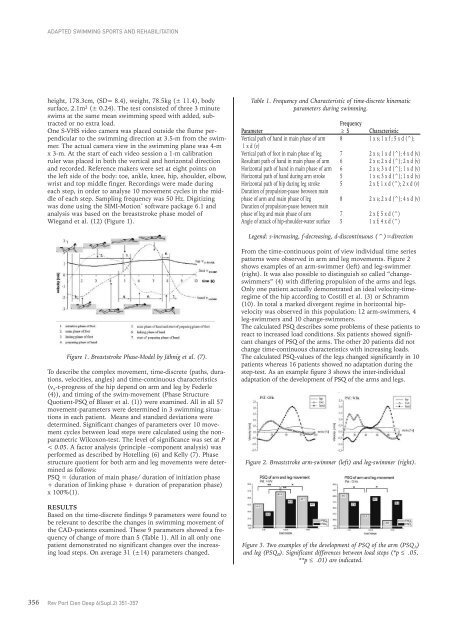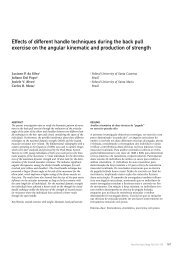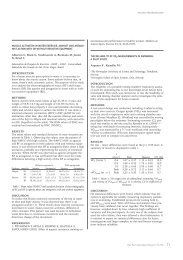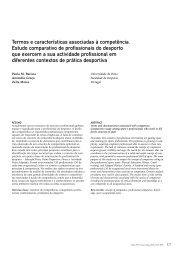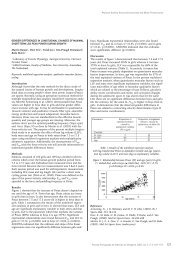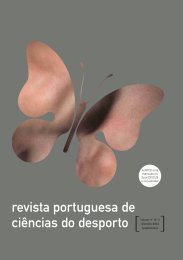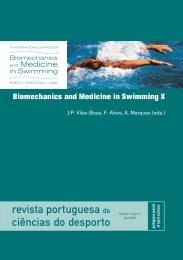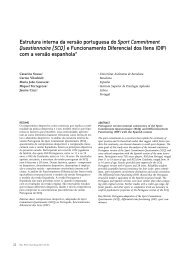adapted swimming sports and rehabilitation
adapted swimming sports and rehabilitation
adapted swimming sports and rehabilitation
You also want an ePaper? Increase the reach of your titles
YUMPU automatically turns print PDFs into web optimized ePapers that Google loves.
356<br />
ADAPTED SWIMMING SPORTS AND REHABILITATION<br />
height, 178.3cm, (SD= 8.4), weight, 78.5kg (± 11.4), body<br />
surface, 2.1m 2 (± 0.24). The test consisted of three 3 minute<br />
swims at the same mean <strong>swimming</strong> speed with added, subtracted<br />
or no extra load.<br />
One S-VHS video camera was placed outside the flume perpendicular<br />
to the <strong>swimming</strong> direction at 3.5-m from the swimmer.<br />
The actual camera view in the <strong>swimming</strong> plane was 4-m<br />
x 3-m. At the start of each video session a 1-m calibration<br />
ruler was placed in both the vertical <strong>and</strong> horizontal direction<br />
<strong>and</strong> recorded. Reference makers were set at eight points on<br />
the left side of the body: toe, ankle, knee, hip, shoulder, elbow,<br />
wrist <strong>and</strong> top middle finger. Recordings were made during<br />
each step, in order to analyse 10 movement cycles in the middle<br />
of each step. Sampling frequency was 50 Hz. Digitizing<br />
was done using the SIMI-Motion “ software package 6.1 <strong>and</strong><br />
analysis was based on the breaststroke phase model of<br />
Wieg<strong>and</strong> et al. (12) (Figure 1).<br />
Figure 1. Breaststroke Phase-Model by Jähnig et al. (7).<br />
To describe the complex movement, time-discrete (paths, durations,<br />
velocities, angles) <strong>and</strong> time-continuous characteristics<br />
(v x-t-progress of the hip depend on arm <strong>and</strong> leg by Federle<br />
(4)), <strong>and</strong> timing of the swim-movement (Phase Structure<br />
Quotient-PSQ of Blaser et al. (1)) were examined. All in all 57<br />
movement-parameters were determined in 3 <strong>swimming</strong> situations<br />
in each patient. Means <strong>and</strong> st<strong>and</strong>ard deviations were<br />
determined. Significant changes of parameters over 10 movement<br />
cycles between load steps were calculated using the nonparametric<br />
Wilcoxon-test. The level of significance was set at P<br />
< 0.05. A factor analysis (principle –component analysis) was<br />
performed as described by Hotelling (6) <strong>and</strong> Kelly (7). Phase<br />
structure quotient for both arm <strong>and</strong> leg movements were determined<br />
as follows:<br />
PSQ = (duration of main phase/ duration of initiation phase<br />
+ duration of linking phase + duration of preparation phase)<br />
x 100%(1).<br />
RESULTS<br />
Based on the time-discrete findings 9 parameters were found to<br />
be relevant to describe the changes in <strong>swimming</strong> movement of<br />
the CAD-patients examined. These 9 parameters showed a frequency<br />
of change of more than 5 (Table 1). All in all only one<br />
patient demonstrated no significant changes over the increasing<br />
load steps. On average 31 (±14) parameters changed.<br />
Rev Port Cien Desp 6(Supl.2) 351-357<br />
Table 1. Frequency <strong>and</strong> Characteristic of time-discrete kinematic<br />
parameters during <strong>swimming</strong>.<br />
Frequency<br />
Parameter ≥ 5 Characteristic<br />
Vertical path of h<strong>and</strong> in main phase of arm 8 1 x s; 1 x f ; 5 x d (^);<br />
1 x d (v)<br />
Vertical path of foot in main phase of leg 7 2 x s; 1 x d (^); 4 x d (v)<br />
Resultant path of h<strong>and</strong> in main phase of arm 6 2 x s; 2 x d (^); 2 x d (v)<br />
Horizontal path of h<strong>and</strong> in main phase of arm 6 2 x s; 3 x d (^); 1 x d (v)<br />
Horizontal path of h<strong>and</strong> during arm stroke 5 1 x s; 3 x d (^); 1 x d (v)<br />
Horizontal path of hip during leg stroke 5 2 x f; 1 x d (^); 2 x d (v)<br />
Duration of propulsion-pause between main<br />
phase of arm <strong>and</strong> main phase of leg 8 2 x s; 2 x d (^); 4 x d (v)<br />
Duration of propulsion-pause between main<br />
phase of leg <strong>and</strong> main phase of arm 7 2 x f; 5 x d (^)<br />
Angle of attack of hip-shoulder-water surface 5 1 x f; 4 x d (^)<br />
Legend: s-increasing, f-decreasing, d-discontinuous (^)=direction<br />
From the time-continuous point of view individual time series<br />
patterns were observed in arm <strong>and</strong> leg movements. Figure 2<br />
shows examples of an arm-swimmer (left) <strong>and</strong> leg-swimmer<br />
(right). It was also possible to distinguish so called “changeswimmers”<br />
(4) with differing propulsion of the arms <strong>and</strong> legs.<br />
Only one patient actually demonstrated an ideal velocity-timeregime<br />
of the hip according to Costill et al. (3) or Schramm<br />
(10). In total a marked divergent regime in horizontal hipvelocity<br />
was observed in this population: 12 arm-swimmers, 4<br />
leg-swimmers <strong>and</strong> 10 change-swimmers.<br />
The calculated PSQ describes some problems of these patients to<br />
react to increased load conditions. Six patients showed significant<br />
changes of PSQ of the arms. The other 20 patients did not<br />
change time-continuous characteristics with increasing loads.<br />
The calculated PSQ-values of the legs changed significantly in 10<br />
patients whereas 16 patients showed no adaptation during the<br />
step-test. As an example figure 3 shows the inter-individual<br />
adaptation of the development of PSQ of the arms <strong>and</strong> legs.<br />
Figure 2. Breaststroke arm-swimmer (left) <strong>and</strong> leg-swimmer (right).<br />
Figure 3. Two examples of the development of PSQ of the arm (PSQ A)<br />
<strong>and</strong> leg (PSQ B). Significant differences between load steps (*p ≤ .05,<br />
**p ≤ .01) are indicated.


